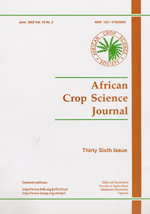
|
African Crop Science Journal
African Crop Science Society
ISSN: 1021-9730
EISSN: 1021-9730
Vol. 4, No. 1, 1996, pp. 79-87
|
 Bioline Code: cs96043
Bioline Code: cs96043
Full paper language: English
Document type: Research Article
Document available free of charge
|
|
|
African Crop Science Journal, Vol. 4, No. 1, 1996, pp. 79-87
| en |
Levels of Three Antifungal Proteins During Development, Germination and in Response to Fungal Infection in Grain Sorghum
Kumari, R. Sunitha; Chandrashekar, A. & Frekeriksen, R.A.
Abstract
An enzyme linked immunosorbent assay (ELISA) for the levels of
three antifungal proteins (18, 26 and 30 kDa) in sorghum
(Sorghum bicolor (L.) Moench) varieties susceptible and
resistant to grain moulds was analysed. The results suggested
that hard and mould resistant grains have higher levels of the
18 kDa and 30 kDa antifungal proteins. The levels of these
proteins were also analysed at 7, 14, 21, 28, 35 and 42 days
alter anthesis during seed development using SDS-PAGE and
ELISA in a variety that was hard and resistant to fungal
infection (E-35-1) and a soft susceptible variety(M-35-I). A
30 kDa antifungal protein increased in amount in developing
seeds from 7 days after anthesis up to 28 days and decreased
thereafter. Two other antifungal proteins (18 and 26 kDa)
appeared in seed sample 14 days after anthesis. The resistant
variety contained more of 30 and 18 kDa antifungal proteins at
all developmental stages. Levels of the 26 kDa protein
increased in the susceptible variety after inoculation of
grains with Fusarium moniliforme, suggesting its
inducibility. There was little change in the resistant variety
in the levels Of all the three antifungal proteins after
inoculation. During germination the levels of the three
proteins, especially that of the 18 kDa, increased in
extractibility. A complex regulatory mechanism controlling the
levels of three proteins during development and germination is
shown by the present study.
Keywords
Disease resistance, ELISA, grain moulds, inducibility, kDa protein
|
| |
| fr |
Kumari, R. Sunitha; Chandrashekar, A. & Frekeriksen, R.A.
Résumé
Un test d'ELISA etait utilise pour determiner les niveaux de
trois proteines antichampignons (18. 26 et 30 KDa) sur les
varietes du sorgho (Sorghum bicolor (L.) Moench)
susceptibles et resistantes au "grain mould". Les resultats
ont montre que les grains resistants ont des niveaux eleves
(18 KDa et 30 KDa) de proteines antichampignons. Les niveaux
de ces proteines etaient aussi analyses a 7 14 21 28 35 et 42
jours apres l'anthese pendant le developpement de la semence
moyennant les tests de SDS-PAGE et ELISA sur une variete a
grains durs et resistante a l'infection au champignon (E-35-1)
et une variete susceptible a grains moux (M-35-1 ). La
quantite de proteine antichampignon 30 KDa augmentait dans les
semences a partir de 7 jours apres l'anthese jusqu'a 28 jours
puis decroissait. Deux autres proteines antichampignons (18 et
26 KDa) apparaissaient 14 jours apres l'anthese dans
l'echantillon de semences. La variete resistante contenait
plus de proteines antichampignons 10 et 18 KDa a tous les
stades de developpement. Des niveaux de proteines de 26 KDa
augmentaient sur la variete susceptible apres inoculation de
grains avec le Fusarium monoliforme, ce qui prouve son
effet par induction. Il y a peu de changement pour une variete
resistante aux niveaux de tousles trois proteines
antichampignons apres leur inoculation. Durant la germination,
les niveaux de trois proteines particulierement le 18 KDa,
augmentaient leur extraction. Un mecanisme complexe de
regulation controllant les niveaux de trois proteines durant
le developpement et la germination est montre dans la presente
etude.
Mots Clés
Resistance a la maladie, ELISA, grain mould, effet d'induction, proteine kDa
|
| |
© Copyright 1996 - African Crop Science Society
|
|
